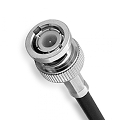Radio frequency (RF) and microwave components route, filter, generate, and control signals from kilohertz into tens of gigahertz for wireless links, radar, test benches, and high-speed data. Signal integrity, low loss, and repeatable performance often determine pass or fail results. Online Components supports that need with reliable stock, U.S.-based shipping, and confidence that comes from an authorized supply chain. Engineers and purchasers get clear specs, fast turnaround, and parts that perform to published specifications.
The RF and Microwave category covers attenuators, amplifiers, mixers, filters such as Surface Acoustic Wave (SAW), power dividers and directional couplers, oscillators and phase-locked loops, RF switches and phase shifters, terminations and loads, circulators and isolators, antennas, waveguide hardware, coaxial cable assemblies, adapters, and connectors like SMA (SubMiniature version A), SMB (SubMiniature version B), Type N, and MMCX (Micro-Miniature Coaxial).
Key specifications include frequency range, impedance (50 or 75 ohms), insertion loss, isolation, Voltage Standing Wave Ratio (VSWR), noise figure, 1 dB compression point (P1dB), third-order intercept point (IP3), power handling, phase noise, temperature rating, and package style. Tight control of these values keeps links stable and predictable in the lab and field.
Start with band and impedance: match each component to the operating frequency plan and keep the entire path at a consistent 50 or 75 ohms. Next, weigh noise, linearity, and VSWR against target performance. You'll want low noise figure for sensitive receivers, strong IP3 and high P1dB for transmitter chains, and low VSWR to tame reflections. Then check power and environment: continuous versus peak power, thermal path, shock and vibration limits, sealing, and connector style that fits the enclosure and tools your technicians use. Finally, confirm footprint and assembly needs, from surface-mount reflow profiles to torque specs for repeatable coax connections.
RF buyers range from design engineers and system integrators to maintenance teams and test labs building fixtures. Common projects include small cells and microwave backhaul, Wi-Fi and Bluetooth gateways, Global Navigation Satellite System (GNSS) receivers, satellite links, and point-to-point radios. Aerospace and defense programs rely on radar front ends, telemetry, and secure communications, while automotive groups run 77 GHz radar and telematics with strict reliability targets. Universities and certification labs round it out with measurement gear, calibration kits, and modular rigs for repeatable experiments across semesters and cohorts.
You get U.S.-based inventory for fast shipping, supplier authentication that guards against counterfeits, and responsive customer service that actually speaks RF. The site makes selection and checkout smooth, and real-time availability keeps projects moving without last-minute surprises. Competitive pricing and low minimums support both prototypes and production runs, while scheduled shipments help teams plan ahead and control build cadence.
RF (Radio Frequency) encompasses the entire electromagnetic spectrum from 3 kHz to 300 GHz, while microwave refers to the subset from 300 MHz to 300 GHz within the RF range. Component data always lists an operating band. Design to that band and validate with the intended modulation and bandwidth.
Voltage Standing Wave Ratio reflects mismatch between stages. A lower value reduces reflections, protects power amplifiers, and stabilizes gain and noise behavior across temperature and frequency.
Connector family sets geometry and repeatability, while cable type drives loss, shielding, bend radius, and phase stability. Keep impedance consistent end-to-end, choose the shortest practical run, and verify torque specs for repeatable measurements.
Calibrate and set reference planes on network analyzers, inspect connector cleanliness, and track temperature drift during sweeps. A five-minute sanity check often saves hours spent chasing phantom mismatches.
P1dB (1 dB compression point) indicates when an amplifier starts to compress, while IP3 (third-order intercept point) measures linearity. Higher values generally support cleaner transmit chains and tougher mixed-signal environments.
See More



